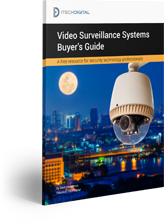Security in high-rise offices and commercial buildings is critical to all parties involved. Property Management wants to protect their facility from vandalism and provide a safe environment for their tenants to maintain building occupancy. Tenants want to know that their employees and leased space is safe and a secure work environment.
There are four key areas to focus on to truly make your tenants and their employees feel safer at work.
- Video surveillance in the interior common areas, including elevator lobby and the back of the house receiving areas
- Exterior video surveillance on the common parking lots and outside loading dock areas
- Access control on all entry points to common spaces
- Access control to elevators
Let me highlight a few key considerations for each of the four areas.
Video surveillance in the interior common areas
Research confirms that video surveillance is a major deterrent to crime in our society. Having cameras that are visible can be a good deterrent to a thief. The criminal mindset is often that there are enough places without video, so why take the chance of getting identified at facility that has them in plain sight?
Video surveillance also provides a visual record/audit trail of everything that takes place within the public places of your facility. With the analytics available on most IP systems today, you can take a proactive approach and look for things like “loitering” and “bag left behind.” Some people approach video surveillance as behind the scenes, but I recommend letting the public know it’s there. This can keep the bad guys away and honest people on the straight and narrow.
Exterior video surveillance
There are a lot of similarities between interior and exterior video surveillance, such as the aspect of a deterrent as well as the analytics that extend the security perimeter to the edges of your property. Exterior areas such as loading docks and the backs of buildings are usually out of sight and out of mind, making them a common way for criminals to breach the building. Video that records on motion and can trigger lights or an audio recording provide outstanding security.
When it comes to exterior video surveillance, one effective solution is the “Virtual Valet.” This is particularly useful when you have a security guard in the front lobby. Because the guard is on duty, he or she cannot leave to walk an employee to his or her car after dark. With Virtual Valet, the guard can pull up the monitor and watch on camera to make sure the tenant reaches his or her car safely.
Access control on all entry points
Controlling and securing all points of entry into your facility while making it easy for your tenants and their customers to come and go is the key to a good access control solution. Identifying public entry points from staff, maintenance, and management perspectives is critical in the design of the solution.
For example, unless your tenants require 24/7 security, the public doors should be open during normal business hours. These should automatically lock after business hours, as well as during weekends and holidays.
The system you choose should accommodate your business needs and should not dictate how you run your business. For example, it’s easy to add a card reader to the tenant’s entry doors that allow them to have a single token to get into work. This can be even offered as a service that creates additional revenue for the building owner or the property management company.
Integrating the access and the video together will enhance your control and understanding of events and alarms such as a door being propped open. If you are managing the building remotely, it is good to be able to verify the alarm and also determine who actually propped open the door.
Access control to elevators
This aspect of the security solution is often overlooked, but the best way to provide building security is to limit after hours elevator access to tenants only. An additional security measure includes limiting tenant access to only the part of the building that they lease.
While we typically recommend a combination of video surveillance and integrated access control, the details really depend on your building. Consider the following:
- Number of floors
- Building location
- Foot traffic
- Neighborhood and crime rates
- Parking lot or garage
- The types of businesses in your building – doctor’s offices, retail stores, consulting firms, etc.
One last consideration is to check with your insurance provider for special discounts for having a facility with video surveillance.
A safe and secure work environment will assist in attracting and maintaining a long-term tenant base. Sometimes ROI on these common area solutions are hard to quantify, but we know a 100% leased building is the goal. Meeting with a security integration provider that will design a system to meet your needs help you will maximize your security and increase your ROI.

